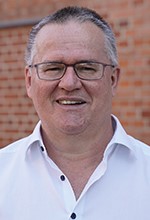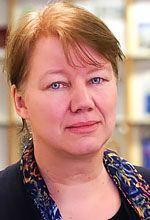Main Content
New Possibilities for Researchand Archives

Innovative forms of research and knowledge transfer, which are predominantly based on digital tools and methods, have played an important role for some time in the Research Area Contemporary History and Archives at the IRS. In this way, the historians are taking up new trends and methods of research that have been gaining momentum in the historical sciences and more generally in the humanities for several years. The key disciplinary concepts are "Citizen Science" in the context of research and "Public History" in the context of research communication. They are intended to contribute to integrating broader strata of society into the knowledge production of historical research and to return scientific findings and results to the interested public in a more targeted manner.
Involving citizens’ knowledge in research and transfer activities is actually nothing new for the team of the Research Area Contemporary History and Archives. The Historical Research Centre of the IRS developed the format of the “Werkstattgespräche” (Workshop Talks) on the history of building and planning in the GDR and practised it for decades. With the Talks, the narrower circle of researchers could be opened up to non-scientific society through interventions by active members of the GDR planning scene as well as other committed and interested persons. In research in the narrower sense, work is also done with contemporary witnesses, for example (see p. 8). Relatively new, on the other hand, are the possibilities that arise from digital infrastructures, tools and media – for archiving, documentation, analysis and communication.
Appropriate approaches are currently being tested and implemented both in research and in the transfer of scientific results to society. In the IRS's spatial research, for example in the Research Area’s Lead Project on the transformation in Berlin-Brandenburg after 1989/90, new approaches of deep mapping are being applied, which are intended to make visible extended dimensions of historical reality beyond conventional methodological approaches such as map and document analyses or interviews with eyewitnesses; showing, for example, overlapping realities of different actors or subjective perceptions. The latter can thus be integrated into research designs and presented on multimedia, temporally differentiated maps on widely accessible websites.
At the IRS, new possibilities for historical research are emerging through the digitalisation of the planning history holdings of the Scientific Collections, which has been accelerated for some time. The provision of a growing proportion of the archive in digital form is often the prerequisite for the presentation of the material on the web in the first place and thus for completely new approaches to historical analysis for broad circles. With the help of special funds from the state of Brandenburg, it was also possible to purchase new hardware and software for creating high-resolution image, sound and video recordings, for determining geodata in space and for simulating buildings and spaces and their development on the PC. In this way, individual buildings or entire city areas can be represented in three-dimensional perspective. If their development over time is also simulated, 4D representations are possible, as they have already been used in archaeology or architecture. The know-how accumulated in the Research Area around the necessary hardware and software can ultimately also be offered as a service to other interested institutions, such as the offices for the preservation of historical monuments.
Another new element is the integration of Citizen Science approaches into historical research, a concept that is also becoming more widespread in the historical sciences and for which there is now even a Green Paper. Both in the project “Stadterneuerung am Wendepunkt” (Urban Renewal at the Turning Point; see p. 8, p. 13), which investigated the struggle of citizens' groups against the decay of old towns in the GDR, and in the project “CitizenArchives” (see p. 22), online tools are being developed that make it easier for citizens to contribute their knowledge and documents on the respective topic or to help with the indexing of archival records. In the end, everyone involved benefits from this, not least the research community. What is decisive is that all these new technological tools and media, together with the digitalisation offensive in the archives, offer potential for truly innovative research, which without them would not be achievable at all or only with much more effort using conventional means.
In addition to research, the transfer of the knowledge gained to society is becoming increasingly important for research institutions and is – quite rightly – increasingly demanded by the funders of research such as ministries or foundations. New media and formats have also been increasingly used in this area recently. For some time now, these have included obligatory websites on individual research projects, but now – as in the “Stadtwende” project – they are provided with interactive map displays fed from deposited databases. Such interactive representations and tools allow users to conduct independent questions and knowledge queries through faceted searches of the presented content, which can not only be more interesting than static representations, but in turn enable new research activities.
But other products have also been advanced and tested recently. These include, for example, a podcast on the historical and current social significance of the demolished Palace of the Republic, audio walks on the “authentication” of the building heritage (see p. 18) as well as on the resistance of citizens' groups against the decay of the old city in East Berlin, or forums on social networks actively co-created by individual researchers of the Research Area, for example on the significance of the architectural Modernism of the GDR. All these formats are organised with the aim of connecting experts with lay people from the middle of society.
The advantages of the new media approaches are obvious: with digital tools and a participatory approach, research can be carried far more strongly into society; it thus becomes more democratic and supported by a broader social base, i.e. also by people from different social milieus. In particular, the new, technology-supported media and formats of addressing and imparting knowledge provide a lower threshold of access compared to traditional media, and thus the barriers to their reception are lower. This makes research more relevant for society as a whole, because more citizens can engage with topics that interest them. At the same time, however, the new approaches are also helpful for research, which thus is more likely to exit its self-imposed isolation in the famous ivory tower. With the help of digital technologies, new knowledge resources are opened up in the form of the participation of lay people, whose contributions have tended to be underestimated in research up to now.
The target group of the new mediation approaches are the citizens who finance research through their taxes and are sometimes also very interested in individual topics. We especially direct our findings via these new formats to people who can provide important, previously undiscovered documents on the topic, with the help of which research can be conducted and which can additionally be made permanently available to the public and research via the archive. However, we are also interested in getting in touch with individuals, groups, local history societies, historical associations or such lay people who are interested in individual topics, buildings or towns or who can even provide material, photos or knowledge themselves on certain facts depicted in photos or documents. This in turn enriches research and the archive.
New approaches to historical research and knowledge transfer supported by digital media and technologies are thus by no means a substitute for established research methods and communication formats. The latter retain their justification. Rather, it is a matter of strategically integrating new approaches into previous research and communication designs in a meaningful way and thus addressing broader sections of the population and new groups of recipients to whom access has often not been so easy to find to date.



